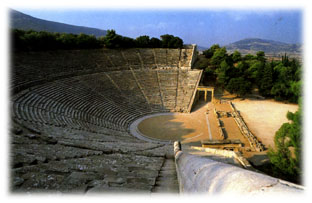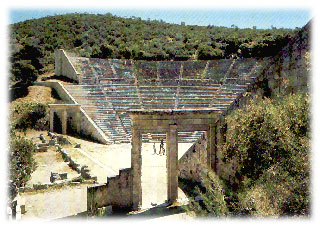The Theater
Description of the Theater
The orchestra (or dancing floor) has the shape of a perfect circle, with
a diameter just above 19,50 meters. A circular base still
preserved at its exact center most probably held an Altar to Dionysos,
called Thymele. The orchestra was the performing ground for the "choros"
of the Greek drama.
Symmetrically placed within the circle of the orchestra are the three
geometrical centers of the concave seat wedges forming a triangle with
two very closed and one very wide corner angle pointing to the auditorium.
The one exactly coinciding with the center of the orchestra is also the
center of the 8 central wedges of the lower part, while the two sets of
wedges at either side have their centers located at each distant corner
of the triangle, on a line parallel to the Stage. Being
extensions of the seat wedges of the lower part, those at the upper part
follow the same geometry. This choice of geometrical features enables better
visibility, without disturbing the impression of a perfect shape. The lower
part of the auditorium has 34 rows of seats and the upper 21, bringing
the total to 55, with a capacity of about 14000 spectators. As in most
hellenic theaters, the lowest row of seats has the form of a continuous
throne, reserved for state officials, priests, and other important personages.
Through a pair of drains at both ends of the circular corridor between
the orchestra and the lowest row of seats, the rain water running down
from the stone cavea was driven into an underground drainage system and
carried away.
Being
extensions of the seat wedges of the lower part, those at the upper part
follow the same geometry. This choice of geometrical features enables better
visibility, without disturbing the impression of a perfect shape. The lower
part of the auditorium has 34 rows of seats and the upper 21, bringing
the total to 55, with a capacity of about 14000 spectators. As in most
hellenic theaters, the lowest row of seats has the form of a continuous
throne, reserved for state officials, priests, and other important personages.
Through a pair of drains at both ends of the circular corridor between
the orchestra and the lowest row of seats, the rain water running down
from the stone cavea was driven into an underground drainage system and
carried away.
The auditorium had a slope of about 26 degrees. Strong lateral retaining
walls held both of its side limits facing outwards to the stage building.
A tower of unknown function crowned their top at either side. The two oblong
passages left between the retaining walls and the stage building at either
side formed the "parodoi" (passageways). Spectators taking their seats
at the lower part of the auditorium would enter the theater through them,
and so would the "choros" during the performance.  Two imposing gateways
made of stone, with pilasters carrying an ionic entablature, architecturally
linked the stage building to the auditorium. Each had twin openings, one
leading directly to the orchestra ground, the other onto the stage via
a ramp. Metal grills placed within these openings secured the theater,
when not in operation.
Two imposing gateways
made of stone, with pilasters carrying an ionic entablature, architecturally
linked the stage building to the auditorium. Each had twin openings, one
leading directly to the orchestra ground, the other onto the stage via
a ramp. Metal grills placed within these openings secured the theater,
when not in operation.
In its final phase during the late Hellenistic period the stage building
was a two-storey structure with a single storey projection towards the
orchestra. The stage building consisted of the following parts:
|
-
The "Proskenion" (fore-stage) This was a single-storey projection towards
the circular orchestra raising to a height of 3.5 meters. Its side facing
the spectators had the form of an elegant colonnade in the ionic order,
with gate-like wings at either end.
-
The free, flat space exactly above the proskenion was called "Theologeion".
There the main "hypocritae" (actors) would act their parts of the drama
during the performance. The theologeion was accesible from both sides via
the ramps entered through the openings at the gateways.
-
Behind the proskenion and the theologeion lay the stage proper, a two-storey
building. Its groundfloor was called the "Skene" (stage) and had four columns
carrying the upper floor called "Episkenion" (over-the-stage). The front
side of the episkenion facing the spectators was open, with four pillars
that covered the span from side to side. The openings between the pillars
were blocked with hanging "pinakes" (backcloth screens) carrying painted
settings appropriate for each play.
|
|
 Being
extensions of the seat wedges of the lower part, those at the upper part
follow the same geometry. This choice of geometrical features enables better
visibility, without disturbing the impression of a perfect shape. The lower
part of the auditorium has 34 rows of seats and the upper 21, bringing
the total to 55, with a capacity of about 14000 spectators. As in most
hellenic theaters, the lowest row of seats has the form of a continuous
throne, reserved for state officials, priests, and other important personages.
Through a pair of drains at both ends of the circular corridor between
the orchestra and the lowest row of seats, the rain water running down
from the stone cavea was driven into an underground drainage system and
carried away.
Being
extensions of the seat wedges of the lower part, those at the upper part
follow the same geometry. This choice of geometrical features enables better
visibility, without disturbing the impression of a perfect shape. The lower
part of the auditorium has 34 rows of seats and the upper 21, bringing
the total to 55, with a capacity of about 14000 spectators. As in most
hellenic theaters, the lowest row of seats has the form of a continuous
throne, reserved for state officials, priests, and other important personages.
Through a pair of drains at both ends of the circular corridor between
the orchestra and the lowest row of seats, the rain water running down
from the stone cavea was driven into an underground drainage system and
carried away.
 Two imposing gateways
made of stone, with pilasters carrying an ionic entablature, architecturally
linked the stage building to the auditorium. Each had twin openings, one
leading directly to the orchestra ground, the other onto the stage via
a ramp. Metal grills placed within these openings secured the theater,
when not in operation.
Two imposing gateways
made of stone, with pilasters carrying an ionic entablature, architecturally
linked the stage building to the auditorium. Each had twin openings, one
leading directly to the orchestra ground, the other onto the stage via
a ramp. Metal grills placed within these openings secured the theater,
when not in operation.